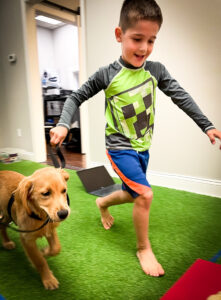Toe walking is when a child walks on his or her tiptoes, without allowing the heel to make contact with the floor. It is very common for a child learning to walk to go through a short period of toe walking lasting less than a month when first learning how to reach on tip toes overhead. However when the child does not resume a typical walking pattern, the toe walking pattern can be problematic. Unless addressed, toe walking can lead to a shortened calf muscle and changes to the bony structure of the foot. These changes will lead to difficulty for the child to participate in age-appropriate activities, decreased balance, and increased risk for falls. While toe walking can seem minor at times, when not addressed it can lead to major difficulties later in life. This is important as it can prevent more extreme intervention when your child is older, such as surgery.
Physical therapy, frequently alongside occupational therapy, can work with your child and find the underlying cause for the toe walking, as well as work to improve their walking pattern. During your child’s physical therapy session, they may receive
- Manual Therapy
- Instrument assisted soft tissue mobilization
- Therapeutic exercise
- Balance Training
- Vestibular Training
- Oculomotor Training
- Biofeedback Training
- Electrical Stimulation
- Kinesiotaping
- Serial casting
- Gait training

